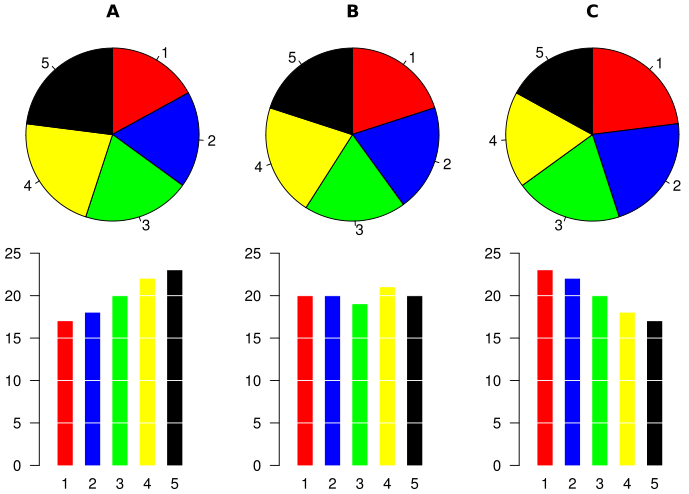Teaching:TUW - UE InfoVis WS 2008/09 - Gruppe 09 - Aufgabe 1 - Types of Data (quantitative vs. qualitative)
Definition[edit]
Qualitative Data[edit]
Quantitative Data[edit]
Additionally, quantitative data can be divided into discrete and continuous data.
Discrete Data
They can take specific numeric values. For Example: shoe size, age,...
Continuous Data
They can take any numerical value. For Example: weigth, width,...
Qualitative Research[edit]
Qualitative research is used when the goal is a complete and detailed description of the subject. The data is not presented in form of numbers an statistics as in quantitative data, but in the form of words, pictures and objects. Contrary to quantitative methods it is much more subjective, because the observations which are made during a research are strongly dependent on the researcher's interpretation.
In most cases qualitative methods aim to gather an in-depth understanding of human behavior and the causes that affect human behavior. There are many different ways of doing qualitative research: Qualitative data can e.g. be gained through
- in-depth interviews with persons or groups
- direct observation
- referring to existing written papers.

Quantitative Research[edit]
Quantitative research is done by systematically collecting and analyzing numerical data concerning the subject. The researcher has to know clearly in advance what he/she is looking for, i.e. all aspects of the study have to be carefully designed before the data is collected. Based on the collected quantitative data statistical models can be constructed or hypotheses can be developed. One advantage of quantitative research is, that it tends to stay more objective than qualitative research. But because quantitative methods are only supplied with numerical data, the results often lack details.
Quantitative research is widely used in both, natural and social sciences.
Example: Qualitative Data vs. Quantitative Data[edit]
In this example the difference between qualitative and quantitative data is shown. Each bullet point describes a certain attribute of a freshman class. On the left side you can see some qualitative data of the class. Obviously this data can only be gained through a close and continuous observation of the class. On the right side quantitative data of the class is shown. It contains purely numerical and statistical data.
|
Qualitative data:
|
Quantitative data:
|
References[edit]
- [Neill, 2007] James Neill. Qualitative versus Quantitative Research: Key Points in a Classic Debate. Created at: February 28, 2007. Retrieved at: November 24, 2008. http://wilderdom.com/research/QualitativeVersusQuantitativeResearch.html.
- [Roberts, 1999] Donna Roberts. Qualitative vs Quantitative Data. Oswego City School District Regents Exam Prep Center. Created at: 1999. Retrieved at: November 24, 2008. http://www.regentsprep.org/Regents/math/ALGEBRA/AD1/qualquant.htm.
- [Wikipedia, 2006] Crissyd. Numerical data. Created at: February 22, 2006. Retrieved at: November 24, 2008. http://en.wikipedia.org/wiki/Quantitative_data.
- [Wikipedia, 2003] 62.151.154.241. Qualitative data. Created at: August 8, 2003. Retrieved at: November 24, 2008. http://en.wikipedia.org/wiki/Qualitative_data.
- [Wikipedia, 2003] Sheldon Rampton. Quantitative research. Created at: December 05, 2003. Retrieved at: November 24, 2008. http://en.wikipedia.org/wiki/Quantitative_research.
- [Wikipedia, 2003] Trontonian. Qualitative research. Created at: November 18, 2003. Retrieved at: November 24, 2008. http://en.wikipedia.org/wiki/Qualitative_research.
- [Wikipedia, 2004] Chmod007. Pie Chart. Created at: June 15, 2004. Retrieved at: November 26, 2008. http://en.wikipedia.org/wiki/Pie_chart
- [Reynolds, 2001] A. J. Reynolds. Types of Data. Centre for Innovation in Mathematics Teaching. Created at: January, 2001. http://www.cimt.plymouth.ac.uk/projects/mepres/book7/bk7i11/bk7_11i1.htm.
- [Trochim, 2006] William M. K. Trochim. Types of Data. Research Methods Knowledge Base. Created at: October 20, 2006. Visited at: November 03, 2009. http://www.socialresearchmethods.net/kb/datatype.php.